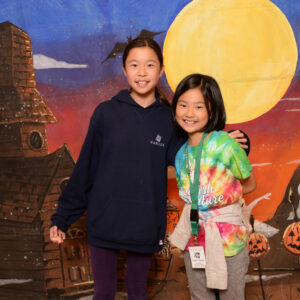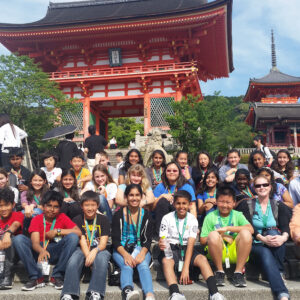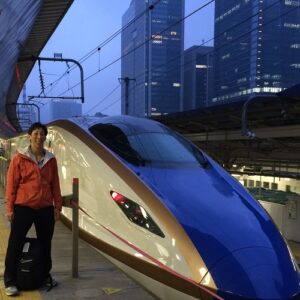The annual middle school trip to Japan in mid-May took 23 grade 6 students across the Pacific to meet with their buddies at Tamagawa Academy, and see many of the country’s cultural and geographic landmarks. After arriving in Tokyo on May 11, the students spent a couple of days exploring the city. They visited the Edo-Tokyo Museum, the Sumo Museum and the Anime Museum, where they learned about the process of making an animated film.
Tamagawa Academy gave Harker a warm welcome on May 13, despite less-than-savory weather conditions. “Despite the heavy rain, we were greeted with excitement, big smiles, and hugs from Tamagawa buddies, parents and teachers,” reported Alana Butler, middle school dean of students, who served as a chaperone on the trip. Both Tamagawa and Harker students gave speeches, and Tamagawa’s middle school headmaster welcomed the Harker representatives and offered his appreciation for the 21-year relationship between the two schools. Following the ceremony, Harker students left with their homestays for the remainder of the weekend.
The Harker students spent much of their first full day at Tamagawa attending classes with their buddies, including English, math, science and foreign languages. During a stop at Tamgawa’s agricultural department, “We learned that the university is producing lettuce, selected herbs and fruit using specific LED lights and light combinations,” said Butler. “It was an amazing sight to see!”
The next day started with a brief welcome meeting with Tamagawa head of school Yoshiaki Obara, after which the group headed to the school’s planetarium. “As Keiko of the planetarium program explained, it is rare that a planetarium is attached to a school,” Butler wrote. “Therefore, having one at Tamagawa is truly special.” Later that day, the students attended a special assembly that included performances of karate, ballet, fencing and comedy. Harker students Ashley Ruan, Arissa Huda and Aria Jain performed as well.
The final day of Harker’s visit to Tamagawa began with students participating in the Tamagawa lower school’s morning assembly and daily exercise routine. “As Harker guests, we joined in and brought smiles to many faces,” wrote Butler. They later attended English and music classes at the lower school. “Since the students are very young and at the beginning stages of learning English, lessons involved students walking around and introducing themselves to their new Harker friends,” Butler said.
The students spent the rest of the day with their Tamagawa buddies, attending classes and enjoying lunch before emotional farewells were exchanged. “Hugs, smiles and tears were all present as our Harker students said goodbye to their Tamagawa buddies,” Butler wrote. “Feeling like most parents saying goodbye to their children, the Tamagawa moms and dads were just as sad to see their Harker guest children leave.”
Upon arriving in Kyoto the next day, the group set out to explore the former Japanese capital with their tour guide, Akira. “As we drove around, Akira pointed out foliage, statues and other things that were specific to the area,” wrote Butler. The students and chaperones had a great time watching a kimono fashion show at the Nishijin Textile Center and seeing the Fushimi Shinto shrine. Once the large crowds had subsided, they also walked through Kiyomizu Temple.
On May 19, the group spent their final full day in Japan in Hiroshima, where they toured the Hiroshima Peace Memorial Museum. Local guides Mito and Michiko provided historical facts and personal stories regarding the atomic bomb that was dropped on Hiroshima in August 1945. The students presented 1,000 paper cranes that they had folded, which were left at the Children’s Peace Monument in memory of the wish of Sadako Sasaki, who fell ill following the nuclear attack on Hiroshima and folded origami cranes in the hopes that she would be granted a wish upon folding 1,000 of them, in accordance with an ancient legend.
Their final cultural stop on the trip was at Miyajima Island, where they walked with deer and viewed the Itsukushima Shrine, built more than 1,400 years ago.









